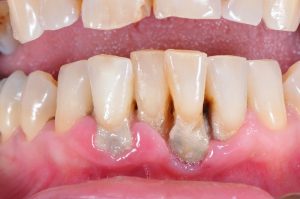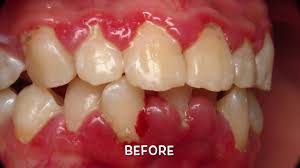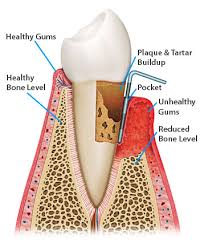What is gum disease?
What is gum disease?
Gum disease, known as periodontal disease is defined as an infection in the tissues that surround and support your teeth. Our mouths are full of naturally occurring bacteria. This bacterium along with mucous and debris form a sticky film called plaque. When plaque is insufficiently removed with both flossing and brushing, it builds up on the teeth and becomes hardened tartar or calculus. Your bodies’ immune system will try and combat this infectious disease with an inflammatory response. Tartar cannot be removed with brushing and flossing alone; a qualified dental professional must remove it.
 Photo from dentalplans.com
Photo from dentalplans.com
Some symptoms you may experience are:
Bad breath that won’t go away; caused by the anaerobic bacteria present
Bleeding when brushing or flossing; plaque buildup and irritation creates inflammation
Gums become red and swollen; forming pockets which harbor harmful bacteria

Appearance of longer teeth, gum recession
Sensitivity; mostly to cold and air due to exposed dentin from recession of gingival tissue
Mobility of teeth; due to bone loss and periodontal pocketing greater than 3mm

Photo courtesy of oralucent.com;
Healthy gums (left with no inflammation or pocketing)
Diseased gums with inflammation, tartar buildup and inflammation on right side.
When left untreated, damaged tissues recede (shown below) and detach from the teeth. This eventually leads to tooth loss. There have been numerous studies linking inflammation of these damaged and diseased tissues to cardiovascular disease, premature birth in pregnant women and diabetes.
The most basic treatment involves the removal of this hardened debris from not only the tooth but root surfaces as well. A qualified dental professional will mechanically remove the tartar (calculus) with an ultrasonic scaler and a combination of hand instruments. Local anesthetic is usually administered in order to provide comfort to the patient. More advanced stages of periodontal disease require surgery and treatment by a Periodontist. Many times the teeth are mobile and a patient could risk losing one or more teeth from bone loss. Gum disease cannot be cured, however it can be controlled and maintained. It is very important to be proactive in your oral hygiene care. Daily brushing and flossing is imperative. Seeing your dentist and/or dental hygienist every 3 to 4 months for periodontal maintenance therapy will allow you to monitor the disease and interrupt any progression before it becomes too late